
A synagogue, sometimes referred to as a shul or a temple, is a house of worship in Judaism. Synagogues have a place for prayer where Jews attend religious services or special ceremonies such as weddings, b'nai mitzvah, choir performances, and children's plays. They also have rooms for study, social halls, administrative and charitable offices, classrooms for religious and Hebrew studies, and many places to sit and congregate. They often display commemorative, historic, or modern artwork alongside items of Jewish historical significance or history about the synagogue itself.
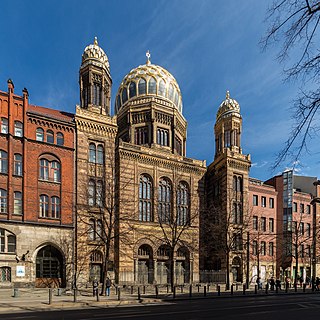
The New Synagogue on Oranienburger Straße in Berlin is a mid-19th century synagogue built as the main place of worship for the city's Jewish community, succeeding the Old Synagogue which the community outgrew. Because of its eastern Moorish style and resemblance to the Alhambra, the New Synagogue is an important architectural monument in Germany.

Roonstrasse Synagogue, located in Cologne, Germany, is the only surviving of the five synagogues of the city before the Nazi era.

Hagenow is a German town in the southwest of Mecklenburg-Western Pomerania, in the district of Ludwigslust-Parchim, 30 kilometers south of Schwerin. Its population is approximately 11,300 inhabitants (2013).

The Fasanenstrasse Synagogue was a liberal Jewish synagogue in Berlin, Germany opened on 26 August 1912. It was located in an affluent neighbourhood of Charlottenburg on Fasanenstrasse off Kurfürstendamm at numbers 79–80, close to the Berlin Stadtbahn and Zoo Station.
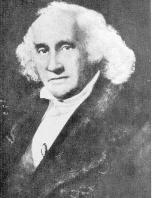
Solomon Ludwig (Levy) Steinheim was a German physician, poet, and philosopher.
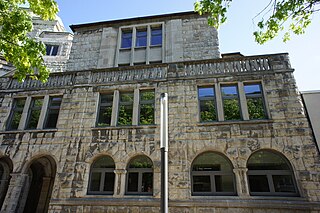
The Salomon Ludwig Steinheim Institute of German-Jewish Studies is a research institute of the University of Duisburg-Essen whose research focuses on the cultural and religious history as well as the history of literature and events of the Jewish community in German-speaking areas. The institute has made contributions in teaching in the field of Jewish Studies at the University of Duisburg-Essen. In 2003, the faculty was transferred to the Heinrich Heine University of Düsseldorf and cooperation with the institute has been maintained.
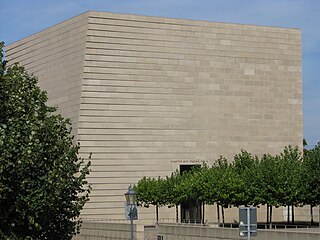
The New Synagogue is a synagogue in the old town of Dresden, Germany. The edifice was completed in 2001 and designed by architects Rena Wandel-Hoefer and Wolfgang Lorch. It was built on the same location as the Semper Synagogue (1839–1840) designed by Gottfried Semper, which was destroyed in 1938, during the Kristallnacht.
Josef Hirsch Janow was a Polish rabbi, who, on account of his great keenness in Talmudical discussions, was commonly called "Hirsch Ḥarif". When in 1776 his father-in-law, Raphael Kohn, was elected rabbi of the 3 congregations Hamburg, Altona, and Wandsbek, he succeeded him as rabbi of Posen. In the following year he was called to the rabbinate of Fürth. In 1779 he interdicted Moses Mendelssohn's German translation of the Pentateuch. Salomon Maimon, in his Lebensgeschichte, highly praises Hirsch Janow for his benevolence. He died at Fürth, Bavaria, on 13 November 1785.

The Great Synagogue, was a synagogue of the Jewish Community of Danzig in the city of Danzig, Germany. It was built in 1885–1887 on Reitbahnstraße, now Bogusławski Street. It was the largest synagogue in the city, and was demolished by the Free City authorities in May 1939.

Rykestrasse Synagogue, Germany's largest synagogue, is located in the Prenzlauer Berg neighbourhood in the Pankow borough of Berlin. Johann Hoeniger built the synagogue in 1903/1904. It was inaugurated on 4 September 1904, in time for the holidays of and around Rosh Hashanah. The synagogue stands off the street alignment and is reached by a thoroughfare in the pertaining front building.
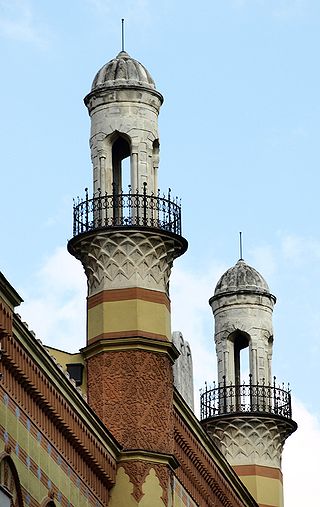
The Rumbach Street synagogue is located in Belváros, the inner city of the historical old town of Pest, in the eastern section of Budapest. The synagogue in Rumbach Street was built in 1872 to the design of the Viennese architect Otto Wagner. Intentionally meant to serve the members of the Neológ community of Pest, its construction coincided with the Schism in Hungarian Jewry of 1869, and it became the home of the more conservative Status Quo faction.

Congregation Beth Israel is a Reform Jewish congregation and synagogue, located at 1931 NW Flanders Street, Portland, Oregon, in the United States.
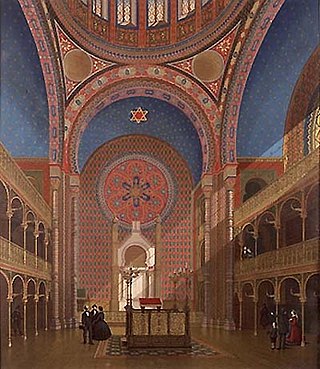
The Synagogue in Glockengasse was a synagogue in Cologne built to the plans of the architect of the Cologne Cathedral, Ernst Friedrich Zwirner. It was built on the previous Monastery of St. Clarissa, where a modest hall of prayer had been erected in the years of the French occupation and had been closed in 1853 because it was unsafe.

The Worms Synagogue, also known as Rashi Shul, is an 11th-century synagogue located in Worms, Germany. Situated in the northern part of the city center, the synagogue is one of the oldest in Germany. Because of its historical importance and its testimony to the European Jewish cultural tradition through millennia, the Worms Synagogue was inscribed on the UNESCO World Heritage List in 2021.

The Alte Synagoge in Erfurt, Germany, is one of the best preserved medieval synagogues in Europe, its oldest parts dating back to the late 11th century. Most parts of the building date from around 1250–1320. Due to the fact that its roof is still standing, it is thought to be the oldest synagogue building intact in Europe and the world.

Spandau Synagogue was a synagogue at 12 Lindenufer in the Old Town area of Spandau, Berlin, Germany. It was also known as Spandauer Vereinssynagoge. The synagogue was built in 1894–95 and was destroyed on 9 November 1938 (Kristallnacht) when it was set on fire. The ruins were removed, probably in 1942. The site is now marked by a memorial tablet, installed in 1988. The congregation maintained a Jewish cemetery, on Spandau's Neue Bergstrasse, which was closed by the Nazi government and was evacuated in 1939 to the Cemetery of the Orthodox congregation Adass Jisroel in Berlin.
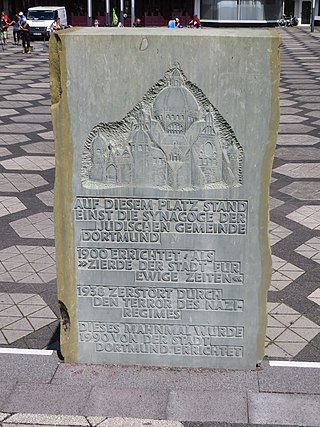
The Old Synagogue was the largest synagogue and cultural center of the Jewish community in Dortmund, Germany.

The synagogue on Fraenkelufer in Berlin's Kreuzberg district was built as an Orthodox Synagogue between 1913 and 1916 according to plans and under the direction of the master builder of the Jewish Community of Berlin, Alexander Beer. The structure was located on Kottbusser Ufer 48–50, today's Fraenkelufer 10-16. On Kristallnacht, the evening of November 9-10th, 1938, the main building of the synagogue was badly damaged. Further destruction in the following years led to the structures ultimate demolition in 1958/1959 after the end of World War II. Today the surviving outbuilding, previously used for the youth service, has been renovated and is home to a Conservative Synagogue. A complete reconstruction of the main synagogue that was destroyed by the Nazis is being planned for its original location.

The Görlitz Synagogue in Görlitz, Germany was built between 1909 and 1911 in the Art Nouveau style and was the main place of worship for the city's Jewish community. Despite an arson attack, the synagogue was one of the few synagogues in the area to survive Kristallnacht, sustaining only minor damage. The damage could have been greater, but was lessened because the firefighters ignored the orders to let the synagogue burn. With the city's Jewish population depleted, the unused synagogue became a ruin in the following decades. In 1991, a restoration project began which was completed in December 2020. Owing to the COVID-19 pandemic, the opening ceremony was postponed until 2021. The synagogue duly opened on July 12, 2021. On September 12, 2022, a new Magen David was placed on top of the synagogue.
























